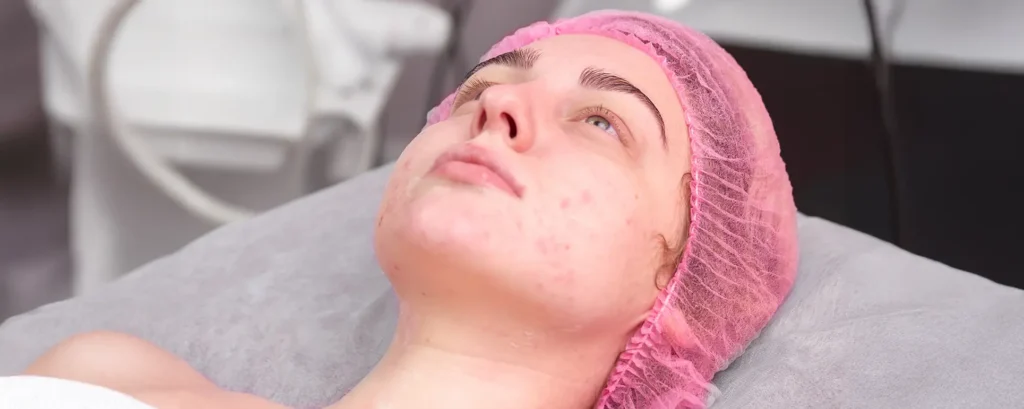If you’re wondering whether it’s really worth seeing a dermatologist for your skin concern, you’re definitely not alone. Many people hesitate, unsure whether their issue is serious enough or if a specialist can truly help. But here’s the truth: whether it’s a stubborn rash that won’t go away, a sudden breakout that’s hurting your confidence, or changes in your hair or nails that you can’t explain these are exactly the kinds of concerns dermatologists deal with every day.
In fact, thousands of people across London visit dermatology clinics each year for help with a wide range of conditions. Some are common but persistent, like acne or eczema. Others come on suddenly, like unexpected hair thinning or nail changes that might signal something more serious. While it’s true that certain mild skin problems can sometimes be managed with over-the-counter products or GP-recommended treatments, there are many cases where seeing a dermatologist is not just helpful it’s essential.
Dermatologists are highly trained specialists who diagnose and treat hundreds of different skin, hair, and nail conditions. They combine medical expertise with clinical experience to provide tailored advice and effective solutions that go beyond the surface.
In this article, I’ll walk you through the most common conditions dermatologists in London treat, explain what each one involves, and share why getting professional care can make all the difference both for your physical health and your peace of mind.
Acne
Acne is by far one of the most common reasons people seek help from a dermatologist and it’s not just a teenage problem. In fact, many adults in London experience persistent or recurring acne well into their 30s, 40s, and even 50s. These breakouts can be incredibly frustrating, especially when they don’t respond to shop-bought products or online skincare tips.
For some, acne might be a mild annoyance occasional blackheads or a few spots before a big event. But for others, it can be much more severe, with painful, inflamed breakouts that leave behind scarring or dark marks. Acne can also take a toll on your mental wellbeing, leading to reduced self-confidence and social anxiety.
What it involves:
- A combination of blackheads, whiteheads, papules (small red bumps), pustules (pus-filled spots), nodules (large, painful lumps), and cysts (deep, inflamed breakouts)
- Often triggered or worsened by hormonal fluctuations (e.g., during menstruation or menopause), stress, poor sleep, certain skincare or haircare products, and genetic factors
- May affect the face, chest, shoulders, and back
- If left untreated, can lead to long-term scarring, enlarged pores, and post-inflammatory pigmentation
How it’s treated:
Dermatologists can offer a wide range of targeted treatments that go far beyond what’s available over the counter. Depending on the type and severity of your acne, your dermatologist may recommend:
- Topical treatments, such as prescription-strength retinoids to unclog pores and boost cell turnover, or antibiotic creams to reduce bacteria and inflammation
- Oral antibiotics to tackle deeper inflammation and prevent further breakouts
- Hormonal therapy, such as spironolactone or the combined oral contraceptive pill, particularly effective for hormonal or cyclical acne in women
- Oral isotretinoin (Roaccutane) for severe, cystic, or treatment-resistant acne this powerful medication is only available under dermatologist supervision
- Procedures like chemical peels, laser treatments, or microneedling, which can help reduce scarring and improve skin texture
In addition to medical treatments, dermatologists also provide tailored advice on gentle skincare routines, helping you avoid products that may worsen inflammation or strip your skin barrier. Instead of relying on trial and error, you’ll get a personalised treatment plan based on your unique skin type, lifestyle, and concerns.
Seeing a dermatologist for acne means more than just clearing up spots it’s about restoring confidence, preventing long-term damage, and taking back control of your skin.
Eczema

Eczema, also known as atopic dermatitis, is one of the most common skin conditions treated by dermatologists in London. While it can develop at any age, it often begins in childhood and for many people, it’s a lifelong condition that comes and goes in unpredictable flare-ups. London’s ever-changing weather, high levels of pollution, and widespread use of central heating in winter can all make symptoms worse.
People living with eczema know how disruptive it can be. The itching alone can interfere with sleep, concentration, and everyday comfort. And if you’re constantly battling flare-ups, it can feel like you’re in a never-ending cycle of scratching, irritation, and embarrassment.
What it involves:
- Dry, red, flaky, and intensely itchy patches of skin
- Skin may become cracked, sore, or weepy in severe cases
- Commonly affects areas like the face, neck, hands, elbows, and behind the knees
- Can occur in both children and adults, with some cases resolving in childhood while others persist or even develop later in life
- Often linked to allergies, asthma, or hay fever, as well as sensitivities to soaps, detergents, fabrics, and food
How it’s treated:
Dermatologists offer a range of treatments to help soothe symptoms, prevent flare-ups, and improve quality of life. These may include:
- Topical corticosteroids to reduce inflammation and calm irritated skin during flare-ups
- Calcineurin inhibitors (like tacrolimus or pimecrolimus) as a steroid-sparing option for sensitive areas such as the face or eyelids
- Emollients and moisturisers to repair and maintain the skin’s natural barrier these are essential for daily management, even when symptoms aren’t active
- Guidance on avoiding triggers, such as certain fabrics, soaps, allergens, and environmental irritants
- In more severe or treatment-resistant cases, dermatologists may recommend:
- Phototherapy (light therapy)
- Oral immunosuppressants (like ciclosporin or methotrexate)
- Biologic injections (like dupilumab) that target specific immune pathways responsible for inflammation
What makes dermatological care so valuable is that it focuses not just on treating flare-ups but also on preventing them. Dermatologists work closely with patients to break the itch-scratch cycle, reduce long-term skin damage, and improve day-to-day comfort. They’ll also help you create a sustainable skincare routine that fits your lifestyle, making it easier to manage your eczema in the long run.
If your eczema isn’t improving with over-the-counter products or you’re finding it difficult to cope with flare-ups, booking a consultation with a dermatologist could make all the difference.
Rosacea

Rosacea is a long-term skin condition that often begins subtly perhaps with occasional flushing or sensitivity and gradually becomes more noticeable over time. Many people mistake it for adult acne, sun damage, or simply “being red-faced,” which is why it frequently goes undiagnosed in its early stages. It’s particularly common in fair-skinned individuals, especially adults between the ages of 30 and 60, and it often affects more women than men though men may experience more severe symptoms.
Living with rosacea can be frustrating. Flare-ups may be unpredictable and are often triggered by everyday factors like heat, spicy foods, stress, alcohol, or even a change in the weather. Without treatment, rosacea can worsen, causing persistent redness and visible blood vessels, which may become permanent over time. In some cases, it can also affect the eyes (ocular rosacea), leading to discomfort or blurred vision.
What it involves:
- Facial redness and flushing, especially across the cheeks, nose, forehead, and chin
- Visible blood vessels (also known as telangiectasia) that give the skin a threadlike or webbed appearance
- Papules and pustules that resemble acne but aren’t caused by the same bacteria
- Burning, stinging, or sensitivity, particularly when using skincare products or exposed to heat
- In some cases, skin thickening, especially around the nose (a condition called rhinophyma), more often seen in men
How it’s treated:
Because rosacea can look different from person to person, dermatologists tailor treatment plans to the specific symptoms and severity of the condition. Treatment options may include:
- Topical prescription creams or gels (such as metronidazole, azelaic acid, or ivermectin) to reduce inflammation and redness
- Oral antibiotics, like doxycycline, to manage inflammatory bumps and pustules during flare-ups
- Laser or intense pulsed light (IPL) therapy to target and reduce visible blood vessels and persistent redness
- Lifestyle and skincare advice, including identifying personal triggers, choosing gentle products, and using daily sun protection (which is crucial for managing rosacea)
Seeing a dermatologist early is key. Timely treatment not only improves the appearance and comfort of your skin but can also prevent permanent changes like skin thickening or persistent vascular damage. A dermatologist will also help you navigate skincare products many people with rosacea struggle with sensitivity and need a carefully chosen routine that soothes rather than irritates.
If your face often feels flushed, irritated, or you’re noticing bumps that won’t go away, it’s worth getting a professional opinion. Rosacea is manageable but the sooner you start, the better the results.
Psoriasis
Psoriasis is a long-term autoimmune condition that affects about 2% of the UK population and is a frequent reason people seek help from dermatologists in London. It occurs when the immune system mistakenly speeds up the life cycle of skin cells, causing them to build up too quickly on the surface. This results in thick, scaly patches of skin that may look red, inflamed, or silvery in appearance.
While psoriasis isn’t contagious, it can be physically uncomfortable and emotionally distressing. Flare-ups can vary in severity from small, isolated patches to widespread plaques that crack and bleed. The condition is also unpredictable, with symptoms that can come and go seemingly at random or be triggered by certain factors like stress, infections, cold weather, or skin injuries.
What it involves:
- Thickened, raised patches of skin (called plaques) with a silvery scale
- Commonly affects the elbows, knees, scalp, lower back, and occasionally nails or the palms and soles
- Can be itchy, painful, or tight, and sometimes causes cracking or bleeding
- May lead to nail changes, such as pitting or separation from the nail bed
- In some cases, psoriasis is associated with psoriatic arthritis, a condition that causes joint pain and stiffness
How it’s treated:
Psoriasis can’t be cured, but dermatologists can help you manage it effectively with a combination of medical treatments and lifestyle strategies tailored to your specific type and severity. These may include:
- Topical treatments, such as:
- Corticosteroids to reduce inflammation
- Vitamin D analogues like calcipotriol to slow skin cell growth
- Coal tar and salicylic acid preparations to soften and reduce scaling
- Phototherapy (light therapy), often used when topical treatments aren’t sufficient this involves exposing the skin to specific wavelengths of ultraviolet light under medical supervision
- Systemic medications for moderate to severe cases, including:
- Methotrexate, ciclosporin, or acitretin (oral medications)
- Biologic drugs like adalimumab, secukinumab, or ustekinumab that target specific parts of the immune system
- Lifestyle support, such as identifying and managing triggers like stress, alcohol, smoking, or certain medications
Seeing a dermatologist is especially important because psoriasis is more than just a skin condition it can affect your joints, nails, and overall health. A specialist can not only help you control the physical symptoms but also screen for associated issues like psoriatic arthritis, depression, or metabolic syndrome, which are more common in people with psoriasis.
Getting the right diagnosis and treatment plan can make a huge difference in your comfort, appearance, and confidence. If you’ve been struggling with red, scaly patches that don’t improve, or you suspect your psoriasis is worsening, it’s worth getting expert advice.
Hair Loss

Hair loss whether it appears as gradual thinning or sudden shedding is one of the most common concerns that bring people to dermatology clinics in London. While it’s often thought of as a male issue, women are just as likely to be affected, especially during periods of hormonal change like pregnancy, menopause, or following illness. The emotional toll can be significant hair is closely tied to identity, and changes in thickness, texture, or hairline can impact confidence and self-esteem.
The challenge is that hair loss isn’t a one-size-fits-all condition. There are many potential causes, and each type requires a different approach to treatment. Without a proper diagnosis, people often spend months or even years trying ineffective over-the-counter products or home remedies.
Common causes include:
- Androgenetic alopecia – Also known as male or female pattern baldness, this is the most common type of hair loss. It’s usually hereditary and results in gradual thinning at the crown or along the hairline.
- Telogen effluvium – A temporary shedding that happens when the body undergoes stress, illness, surgery, or major hormonal shifts (such as after giving birth or recovering from COVID-19). It usually appears as diffuse thinning rather than bald spots.
- Alopecia areata – An autoimmune condition in which the immune system attacks hair follicles, causing round, smooth bald patches on the scalp or other areas of the body.
- Scalp conditions, such as seborrheic dermatitis, psoriasis, or fungal infections, can lead to inflammation that interferes with healthy hair growth.
How it’s treated:
Dermatologists tailor hair loss treatments based on the underlying cause, the severity of the condition, and the patient’s goals. Treatment options may include:
- Prescription topical treatments, like minoxidil (Regaine), which can stimulate hair growth and slow down thinning in both men and women
- Oral medications, such as finasteride (Propecia), typically used in male patients to block the hormone DHT, which contributes to hair follicle shrinkage
- Corticosteroid injections directly into the scalp for people with alopecia areata, to reduce immune activity and stimulate regrowth
- Platelet-rich plasma (PRP) therapy, where the patient’s own blood is processed to extract growth factors and injected into the scalp to encourage hair follicle activity
- Scalp care plans, which might include medicated shampoos, anti-inflammatory treatments, or antifungal products to improve scalp health and create a better environment for hair to grow
- Nutritional and lifestyle support, including advice on supplements (like iron or biotin), stress management, and avoiding harsh styling or chemical treatments
What makes dermatological care so valuable is the diagnostic expertise hair loss can have multiple overlapping causes, and treating the wrong one could delay recovery. A dermatologist will often perform a scalp examination, review your medical history, and may order blood tests or a scalp biopsy to determine the precise cause.
If you’ve noticed more hair in your brush, your part widening, or bald patches forming, don’t wait for it to resolve on its own. Early treatment often leads to better results and gives you peace of mind.
Mole Checks and Skin Cancer Screening
Mole checks are one of the most important services dermatologists provide. Skin cancer rates in the UK are rising, and early detection is key.
What it involves:
- Full-body mole mapping
- Dermatoscopic assessment (using a special magnifying tool)
- Biopsies for suspicious lesions
Signs to watch for:
- Changes in size, shape, or colour
- New moles appearing after age 30
- Itching, bleeding, or crusting
How it’s managed:
- Monitoring benign moles
- Removing suspicious lesions
- Coordinating treatment for confirmed skin cancers
Seeing a dermatologist ensures any worrying changes are picked up early.
Seasonal and Demographic Trends in London
Living in London means your skin is exposed to unique challenges:
- Pollution:
Air pollution contributes to sensitivity, eczema flare-ups, and dullness. - Central heating:
Dry indoor air in winter can worsen eczema and psoriasis. - Stress:
Fast-paced lifestyles can trigger acne and hair loss. - Sun exposure:
Even in the UK, UV damage can cause premature ageing and skin cancers.
Dermatologists in London often see a surge in certain conditions at specific times of year for example, more eczema in winter and more mole checks in summer.
Why See a Dermatologist Instead of Self-Treating?
While there’s no shortage of skincare advice online, seeing a dermatologist offers clear advantages:
- Accurate diagnosis:
They can confirm what condition you actually have many skin problems look similar. - Access to prescription treatments:
Over-the-counter products only go so far. - Monitoring and follow-up:
Long-term conditions like psoriasis and rosacea need ongoing care. - Peace of mind:
You’ll know you’re in safe hands and not missing something serious.
Final Thought: Your Skin Deserves Expert Care
Whatever your skin concern whether it’s acne that won’t clear, eczema that keeps flaring, or a mole you’re worried about help is available.
Seeing a dermatologist isn’t just about appearance; it’s about your comfort, confidence, and long-term health. Ready to take the next step? Get in touch with us to book a consultation with a skilled dermatologist in London and start your journey toward healthier skin.
References:
- Lai YL and Liao YH (2022) ‘Prevalence of most common skin diseases in Europe: a population-based study’, Journal of the European Academy of Dermatology and Venereology, 36(5), pp. 805–813. doi:10.1111/jdv.18050. https://pubmed.ncbi.nlm.nih.gov/35274366/
- Napolitano S et al. (2022) ‘Prevalence of most common skin diseases in Europe: a population‐based study’, PMC, Journal of the European Academy of Dermatology and Venereology. https://pmc.ncbi.nlm.nih.gov/articles/PMC9415115/
- Holzmann R et al. (2022) ‘High prevalence of skin diseases and need for treatment in a middle-aged population: Northern Finland Birth Cohort 1966 Study’, PLoS One, 11(6), e0156980. https://pmc.ncbi.nlm.nih.gov/articles/PMC4049840/
- Tan JK and Bhate K (2015) ‘A global perspective on the epidemiology of acne’, British Journal of Dermatology, 172 Suppl 1, pp. 3–12. https://www.jaad.org/article/S0190-9622%2820%2931074-4/
- van Zuuren EJ and Fedorowicz Z (2015) ‘Interventions for rosacea: abridged updated Cochrane systematic review including GRADE assessments’, British Journal of Dermatology, 172(6), pp. 1462–1471. https://en.wikipedia.org/wiki/Rosacea
